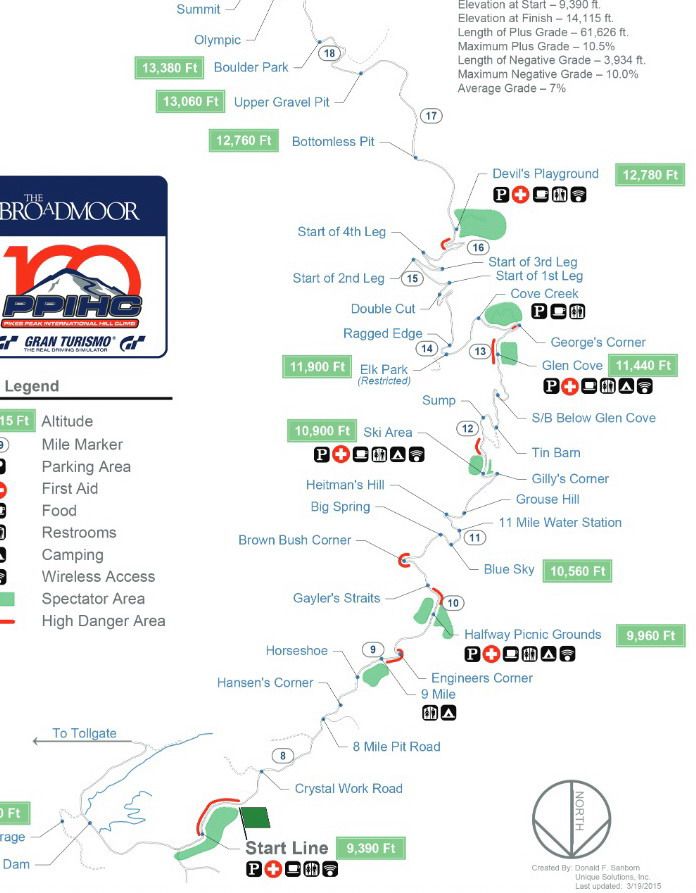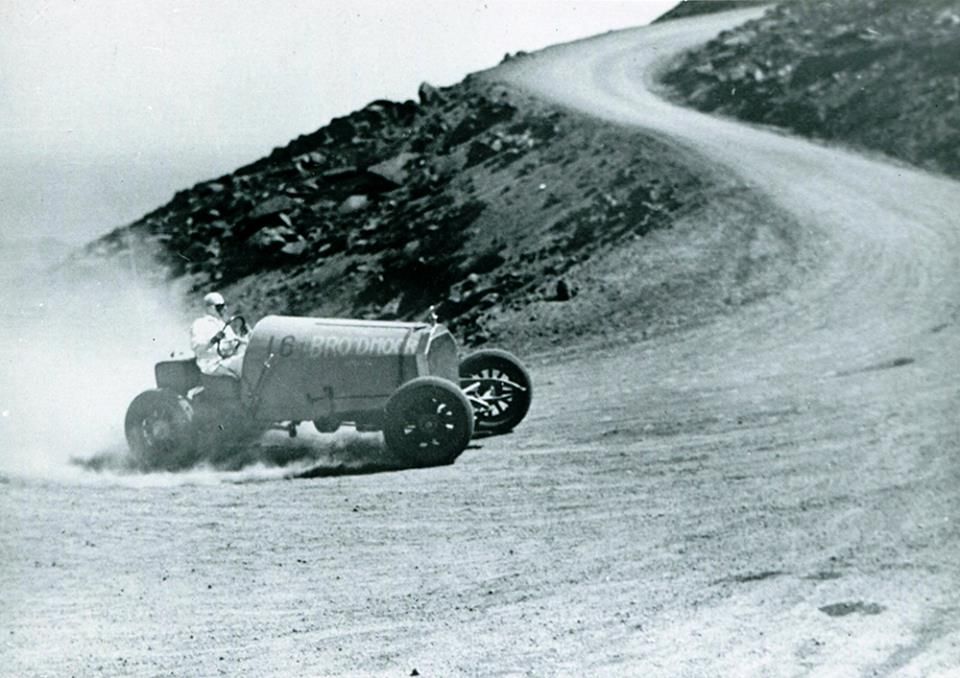In 1916, Coloradan businessman Spencer Penrose sponsored a motor race up the newly improved Pikes Peak Highway as a means to promote tourism. Eventually, the invitational grew to become one of the most important races of the year, attracting the world’s top drivers and playing host to a field of cutting-edge go-fast machinery. Now, exactly 100 years after the inaugural “Race to the Clouds,” the Pikes Peak International Hill Climb (PPIHC) marches forward as an unparalleled challenge to both man and machine, probing limits by way of unpredictable weather conditions, power-sapping altitude, and potentially lethal danger. This is the race for America’s Mountain.
Held annually during the final Sunday of June, the PPIHC sees its 94th running this year, making it one of the oldest motor races in the world. Sprinting to the peak will be a collection of 100 vehicles, including race cars, streets cars, EVs, quads, trucks, motorcycles, and sidecars, all of which fall into broad classifications meant to accommodate diversity and technological innovation.
Vying for glory alongside the Americans will be an international crowd of drivers, with representatives from Australia, Canada, Finland, France, Japan, Taiwan, and the U.K. Last year, outright victory went to Rhys Millen and the all-electric Drive eO PP03, marking the first time an all-electric vehicle clinched top honors at the event. This year, Millen will look to go back-to-back in the updated eO PP100, while Acura joins the fray with a trio of NSX’s. Challenging the battery-suckers will be a hoard of internal-combustion-only opponents, from open-wheel formula cars, to European track weapons, to Japanese rally specials, to big-displacement American muscle.
From this motley crew, who will rise to the top? Read on for a breakdown of this year’s PPIHC.
Continue reading for more information on the 2016 Pikes Peak International Hill Climb.
The Course
The PPIHC takes place on the Pikes Peak Highway, beginning at mile-marker 7 and ending at the 14,110-foot crest. The route is 12.42-miles long and incorporates 156 turns, climbing a total of 4,720 feet over gradients averaging 7.2 percent. The road originally consisted of both dirt and tarmac surfaces, but was fully paved in 2011, consequently attracting some of the fastest vehicles on the planet.
One of the biggest standout features of the race is the high altitude’s effect on both man and machine. At 10,000+ feet, drivers could struggle to concentrate on the task at hand, with the thin air causing things like headaches, loss of appetite, and trouble sleeping. And since the event doesn’t take place on a dedicated race track, there’s very little available practice time, which means veterans are usually favored.
Like the drivers, the cars will also experience a reduction in performance, with lower output from the internal combustion engines (power can drop by as much as 30 percent between the start and finish lines), a drop in cooling system efficacy, and lower downforce from the aerodynamics.
These factors will make forced induction and electric power all the more potent. Interestingly, General Electric used Pikes Peak as the locale to test turbocharged aircraft engines in 1918, demonstrating how the technology could be used to eliminate power loss from low air pressure and density.
Racing Classes And Divisions
There are four car divisions making up this year’s roster, with the majority of the divisions separated into several individual classes.
You can view a full list of the competitors and what they’ll be driving here.
Below, we give an analysis of each division and class, plus all the big names to look out for.
Electric Car Division
The PPIHC is framed as an ideal location to explore new racing technology, so it makes sense to have an entire division devoted to EVs. After all, “electric is the future,” or so we hear.
Scratch that – electric isn’t the future. Electric is the now. Rhys Millen and Nobuhiro Tajima proved as much by going 1-2 in battery-powered racers last year, and now, all eyes are the Electric Car division to see if 2015 was the start of a trend.
And why not? After all, no combustion means no power loss at high altitude, which means EVs should have a leg up on the way to the peak, right?
Yes and no. While all-electric drivetrains do offer an alternative to atmosphere dependence, they also come with several drawbacks, the biggest of which is weight. All those motors and batteries add a fair amount of mass to the vehicle, and whether or not the extra output can overcome the weight penalty isn’t totally clear.
There are two classes within the Electric Car Division – the zany Electric Modified class, and the more pedestrian Electric Production class. While rules for the former are relatively open, rules for the latter stipulate that entries must be mass-produced vehicles available to the general public (pretty much stock spec).
Electric Modified
Rhys Millen set the Modified class record last year by going 9:07.222 in the Drive eO PP03. This year, he’s back, driving an upgraded Drive eO racer called the PP100. All the essentials are the same, but there are numerous updates as well, including better cooling, and an extra electric motor on the rear axle to enhance power delivery. The car uses a 50-kWh battery pack, seven electric motors total, and colossal 320/710R18 racing slicks from Hankook. Output is rated at 1,600 horsepower and 1,860 pound-feet of torque – improvements of 230 horsepower and 260 pound-feet of torque compared to 2015.
For Millen, the goal is simple – go faster.
“Last year was a big leap in understanding electric car performance, drivability and chassis balance,” Millen said in a press release. “With several small tweaks, planned pre-event mountain testing and the support from Hankook Tire with a specially constructed tire and compound, I feel the team and I are more prepared this year than ever before.”
And that’s good, because he’s gonna have a Monster on his tail. Close behind Millen will be Nobuhiro Tajima, nicknamed “Monster,” who, despite suffering a brake failure, snagged second place last year in the Tajima Rimac e-Runner Concept_One. This year, Tajima and company are once again gunning for the top spot, and they’re coming prepared with a new e-Runner boasting better aero, new suspension, the latest software update, and a tweaked all-wheel torque vectoring system. Output is rated at 1,475 horsepower.
But it’s not just the technical specs that make the Tajima team so dangerous. The Monster behind the wheel is also a bona fide Pikes Peak expert, with a list of accomplishments that includes an all-time course record set in 2011 (the record was later broken by Sebasiten Loeb in 2013). “I will do this race until I die,” Tajima said last year. “I must do this race.”
But as Millen and Tajima battle for supremacy, make sure to keep an eye on the NSX EV Concept from Acura. As part of a trio of factory-backed NSX’s climbing the hill this year (look for the other two in the Time Attack Division), the EV Concept is undoubtedly the biggest and baddest. Under the oversized aero is the next evolution of Acura’s Super Handling All-Wheel Drive (SH-AWD) system, an in-development prototype that also saw use in the class-winning CR-Z concept last year. But in addition to being newer, the NSX EV Concept is also significantly more powerful than the CR-Z concept, packing upwards of three times the all-electric output as its predecessor. Behind the wheel will be Tetsuya Yamamoto, the same hotshoe who piloted the prototype CR-Z in 2015.
Electric Production
In 2014, Roy Richards set the Electric Production class record with a time of 12:55.591. His car? A 2012 Honda Fit EV.
This year, that record will almost definitely be broken, as Blake Fuller is slated to wring out a 2016 Tesla Model S P90D as the sole competitor in the Electric Production class. Personally, I can’t wait to see how the poster child of EV performance stacks up on the mountain.
4-Wheeled Unlimited Division
Given the name, 4-Wheel Unlimited is exactly what you’d expect – if it’s a “car” and it’s safe, it’ll run. Traditionally, this division is home to the fastest machines of the whole event, including several over-the-top experiments in speed. Unlike the other three divisions, there are no sub-classes in Unlimited.
In 2013, rally legend Sebastien Loeb set the current Pikes Peak course record (8:13.878) in a modified Peugeot 208 T16. Running in the Unlimited division, the T16 was specifically tuned for domination at America’s Mountain.
This year, it’s another Frenchman that heads to Colorado looking for a win – Romain Dumas. Fresh from victory at Le Mans, Dumas will tackle the peak in a Norma M20 RD, the same open-cockpit prototype he wheeled to PPIHC glory in 2014. Although it may look similar to the 2014 spec, almost everything about the car is new. The chassis was reworked, the engine got a new turbo, the aero was adjusted, and the curb weight was reduced. The biggest change, however, was the addition of a high-performance AWD system.
Paul Dallenbach is another name that’s sure to top the time sheets this year. With a resume that includes eight PPIHC titles, including an Open Wheel class win in 2015, the Colorado native will be hunting for number nine in a 2006 PVA 03 Dallenbach Special.
Time Attack Division
Some of the closest competition will be in the Time Attack Division, where the cars are production-based and close-bodied, somewhat resembling that thing sitting in your driveway. The division is split into two classes – Time Attack 1 and Time Attack 2 Production, with heavily modified race vehicles populating the former, and stock spec for the latter.
Time Attack 1
Paul Dallenbach set the TA1 class record in 2013 driving a Hyundai Genesis Coupe to the summit in 9:46.001. This year, that time will come under fire from James Robinson and the new Acura NSX. Upgrades to the hybrid are limited to a lowered curb weight and a new exhaust, but considering the support that goes along with driving a factory racer, expect this one to lead the class.
Of course, with a field of 20 cars, the TA1 contest is anything but a lock. Further competition will come from Raphael Astier (2009 Porsche 911 GT3 RS), Robb Holland (2013 Audi TT RS), Tony Brakohiapa (2009 Ford Mustang), Timothy Hardy (1987 BMW E30), and last year’s TA2-winner, David Donner (2013 Porsche GT3R).
Time Attack 2 Production
Donner actually set the TA2 course record in his class-winning run last year, going 10:26.896 in a 2014 Porsche Turbo S.
For 2016, however, Nick Robinson (brother to James) will challenge that in the third and final factory-backed NSX. Also be on the lookout for Kevin Wesley (2016 Dodge Viper ACR) and Jeff Denmeade (2006 Mitsubishi Lancer Evo).
Pikes Peak Challenge Car Division
Established as recently as 2014, the Pikes Peak Challenge Car Division includes a multitude of different classes, roping together entries unsuitable for the more mainstream regulations.
Starting things off is the Open Wheel class, which includes everything from buggies to formula cars. Next is the Open class, where heavily modified production vehicles reign supreme. Then there’s the Vintage Car/Truck class, which was revised for 2016 to only include vehicles produced prior to 1995 with “significant” history at Pikes Peak. Finally, there’s the Exhibition class, where entries can still go for the course record, but aren’t timed against one another.
Open Wheel
Paul Dallenbach holds the class record in Open Wheel as well, going 9:36.496 last year in a 2003 PVA Dallenbach Special.
Clint Vahsholtz might have something to say about that. A Pikes Peak veteran, Vahsholtz has 21 class wins to his name, the most in PPIHC history. Placing third in the Open Wheel class last year, Vahsholtz is looking strong for 2016, taking the helm of a 2013 Ford Open. Spencer Steele will also be at the front of the pack in his 1995 PVA Special.
Open
Before stepping up to 4-Wheeled Unlimited, Romain Dumas set the Open class course record in 2012 with a Porsche GT3R, clocking in at 9:46.181.
This year, Fast N’ Loud co-host Aaron Kaufman will participate in a 1963 Ford Falcon. However, the television star may run into trouble if he hopes to contend with the likes of Layne Schranz (2015 Chevrolet SS) and Raymund Guerrero (2008 Dodge Viper).
But the biggest challenge by far will come from Jonathan Frost, who returns with the same Palatov D2RS Roadster that propelled him to a class win in 2015 (as a rookie, no less).
Also, make sure not to miss Mike Ryan and his 1,500-horsepower Freightliner Cascadia Pikes Peak Special semi-truck – a surefire fan-favorite.
Vintage Car/Truck
This year, only three competitors occupy the vintage category. Most likely to take the class win is returning-champion Christopher Lennon and his 1973 Porsche 911 RSR, followed by Ralph Murdock (1970 Chevrolet Camaro) and Jess Neal (1971 Plymouth Cuda). We’ll see if any of the three have what it takes to reset the class record of 10:46.000, which was set in 2014 by Ralf Christensson (1967 Ford Mustang GT350).
Exhibition
Although we probably won’t see a new course record coming from the three entries in the Exhibition class this year, you should still expect some very competitive times. Look for Dave Balingit (2016 Elan NP01), Donald Hoffman (2016 Radical RXC Turbo 500), and John Stallworth (2014 Polaris XP 1000).
Special Demonstration Runs
Beyond all the competitive timed runs, the PPIHC will also host a few special demonstration runs.
As Rhys Millen goes for his next Pikes Peak victory, father Rod Millen will take a spin in the 1,000-horsepower Pennzoil Toyota Celica he used to set the course record in 1994.
Sam Schmidt, a former IndyCar racer that was paralyzed in a crash in 2000, will also run the course. Using a 2016 Chevrolet Corvette Z06 equipped with semi-autonomous technology, Schmidt will control the car’s steering, throttle, and brakes via head movements. Last month, between qualifying sessions at the Indy 500, Schmidt took the modded ‘Vette up to 152 mph.
How To Experience
While live footage of the 2016 PPIHC will be hard to come by (you can try to watch the camera feeds from the Colorado Springs park service here, but they’re pretty blurry), you can still experience the race via the free official app (Android users click here, Apple users click here).
As you might expect, Twitter will also provide tons of live updates:
@PPIHC
@RhysMillen
@PaulDallenbach
@Monster_Tajima
#PikesPeak
Schedule
Note: all times are local.
Find the complete schedule here.
Friday, June 24th
5:30 AM – 8:30 AM: Sanctioned practice
5:00 PM: Final competitor list and run order announced
Saturday, June 25th
9:00 AM – 5:00 PM: Speed Week Activity – Rocky Mountain SuperEnduro
Sunday, June 26th
7:00 AM: No spectator cars allowed past the starting line
8:00 AM: Green flag drops
Origins And History
Alternately called “The Race to the Clouds,” the PPIHC is the third oldest motoring event in the Western Hemisphere behind the Indy 500 and Isle of Man TT. Past winners here include names like Unser, Andretti, Millen, and Rorhl.
Between 1946 and 1970, the PPIHC was used as a round in the AAA and USAC IndyCar championship. In 1984, the first Europeans entered the fray, with Norweigian rallycross driver Martin Schanche and French rally driver Michele Mouton kicking off what would grow to be international interest in the American event.
In August of 2011, a Sierra Club lawsuit forced tarmac onto 30 percent of the route that remained unpaved. Despite misgivings that the new surface would diminish interest in the event, the PPIHC remains one of the premiere races in the U.S.
The current outright record is held by rally legend Sebastien Loeb, who managed to set a time of 8 minutes, 13.878 seconds in 2013 using a Peugeot 208 T16 entered in the Unlimited Class, smashing the old record set by Nobuhiro Tajima in 2011 by over 90 seconds.



